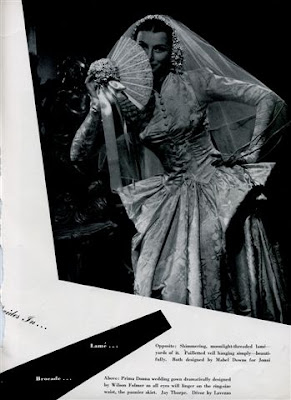
 One of my newest acquisitions is a copy of Bride's Magazine dating back to Fall/Winter 1939. I picked it up downtown (remember I live in San Anselmo, the antiques capital of California). Vintageholic that I am, you can imagine how much inspiration I've picked up studying each page with all the concentration of a scholar. Fashion-wise, 1939 was an interesting year. Gone With the Wind, just released, had incredible influence on evening and bridal with stores rolling out antebellum silhouettes in yards of taffeta and satin. By today's standards, the description on the ad below for The Blum Store in Philadelphia would scare more brides off than sell them . . . .
One of my newest acquisitions is a copy of Bride's Magazine dating back to Fall/Winter 1939. I picked it up downtown (remember I live in San Anselmo, the antiques capital of California). Vintageholic that I am, you can imagine how much inspiration I've picked up studying each page with all the concentration of a scholar. Fashion-wise, 1939 was an interesting year. Gone With the Wind, just released, had incredible influence on evening and bridal with stores rolling out antebellum silhouettes in yards of taffeta and satin. By today's standards, the description on the ad below for The Blum Store in Philadelphia would scare more brides off than sell them . . . .  ---The Victorian Bride has a wedding ring waist. Look like the young Victoria to be the most daring bride of the season, actually! Show off your corseted waist in a wee, wasp bodice and hooped circumference of corded moire. Conceal your arms to the wrist in moire with rose point inserts. Pose for your wedding pictures demure in cap and snood! Ask for Margot in Debutante and Wedding Embassy--Second Floor---
---The Victorian Bride has a wedding ring waist. Look like the young Victoria to be the most daring bride of the season, actually! Show off your corseted waist in a wee, wasp bodice and hooped circumference of corded moire. Conceal your arms to the wrist in moire with rose point inserts. Pose for your wedding pictures demure in cap and snood! Ask for Margot in Debutante and Wedding Embassy--Second Floor-----Here's another: All eyes are trained on m'lady's miniature waist, her alluring round hipline, her proudly held head and shoulders. Bodices are molded skin tight. Skirts are most often extremely bouffant . . . .--
Scanning these ads, I realize how times have changed. Back then the independent bridal salon as we know it now didn't exist. It was the era of the toney department store, the primary place you went to get anything, including gowned. With the birth of the bridal registry at Marshall Fields in 1924, other department stores followed suit. By the 1930s, stores vied to keep customers--especially the bride and her entourage under one roof. They boasted of specialized consultants as well as registry helpers, all in house. Here's a sampling from The H. & S. Pogue Company in Cincinati: Pogue's Bridal Service is yours to use. To help choose your trousseau, your wedding gown , your bridesmaid dresses. To relieve you of the thousands of details that must be looked after with the greatest care to assure you the beautiful serenity that's your right as a bride . . .to make your wedding the perfect thing it should be.
Most top drawer gowns at depression's end ran about two hundred dollars. The one above is stunning in simple details, designed by Joseph Whitehead for Altman. Few designers took credit wholly for their own work as most of any stature were connected to a reputable department store. Those who worked independently were known as having dressmaking establishments and mostly did custom work. The satin gown in the top photo simply credits Sak's Fifth Avenue for the design; this tells us in-house designers were hired to create samples of these gowns that eventually were made to order for each bride. Back then a store's rep carried more weight than the designer names they carried. In the end, places like Bergdorf's took kudos for creating a certain 'bridal look'.Source URL: http://weddingspace.blogspot.com/2009/07/everything-old-is-new-again.html
Visit Wedding Space for Daily Updated Hairstyles Collection













